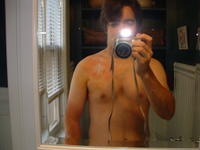 How it all started…
How it all started…
In March of 2004, my sixteen-year-old son, Dave, developed atrial flutter. The only symptom was that he felt “off” for several days, and thought maybe he was coming down with something. When he nearly collapsed after running up a set of stairs, we visited the doctor. Minutes into the exam, his doctor sent us directly to the emergency room. Dave’s ECG (electrocardiograph) showed that his heartbeat was erratic and his pulse was racing. After over 24 hours of drug therapy, during which they administered large doses of digoxin into Dave hoping to correct the heart rhythm, the decision was made to shock his heart back into normal sinus rhythm via cardioversion and he was released from the hospital with a prescription for digoxin. The cardiologists told us that Dave was a healthy teenager, and his heart was strong and normal. They were at a loss to explain why it spontaneously developed an arrhythmia. But the digoxin, to help prevent further occurrences, and follow-up visits, reassured us and Dave went home and picked up life exactly where he’d left off three days earlier.
Six months later, during his follow-up visit, the doctor noticed a unique wave pattern in Dave’s ECG. We learned that day the Dave most likely had Brugada Syndrome. It's rare, and isn’t usually associated with cardiac arrhythmias or flutters. How fortunate we were, that Dave was under the care of cardiologists with the skill to notice this elusive condition. The gave us sobering news: if Dave did have Brugada Syndrome, he was at risk of experiencing sudden cardiac death at any time.
The cardiologist sent us home to spend an anxiety-filled week waiting for there to be a space and time available for Dave's electrophysiology study.
Brugada Syndrome is usually confirmed during an electrophysiology study (EP study) in which a catheter is threaded from a large vein in the groin to the heart. Here electrical activity can be studied and any arrhythmias can be mapped. The ventricle (lower chamber) is then prodded into fibrillation in a controlled setting. A healthy heart will not go into fibrillation. Another method that can be employed is to introduce certain drugs to stimulate fibrillation.
Dave went through the EP study, which confirmed his diagnosis. Before we had begun to absorb what was happening, he was scheduled for next day surgery to have an ICD (implantable cardioverter defibrillator) installed. This seems like a drastic step to take because the surgery is invasive and the ICD is costly. But we learned that there is no cure for Brugada Syndrome. The ICD will shock Dave’s heart back into sinus rythym if he has a Brugada event. Since Dave was at risk of sudden cardiac death, the choice here was simple. His ICD is the only assurance we have that Dave will survive such an event. At the top of this post is a picture of Dave taking a photo of his incision site the day he returned home from the hospital with his ICD.
The story doesn’t end here. Brugada Syndrome is hereditary. Our whole family was tested, and blood drawn for genetic study. My daughter and I showed no characteristic waves in our ECG strips, but Dave’s father, Jim, was found to have the syndrome. He, too, endured the EP study, and the subsequent surgery to have an ICD implanted. During the EP study was able to have an existing atrial arrhythmia condition treated successfully through a procedure called cardiac ablation, and this was good.
The doctor told my daughter that because her genetic make-up is identical to her brother's, she should have a new ECG strip run every now and then and sent to him for review just in case. Another confounding element of Brugada Syndrome is that is doesn't present in an ECG every time, it may appear and disappear over a person's lifetime.
 The Great Race
The Great Race
